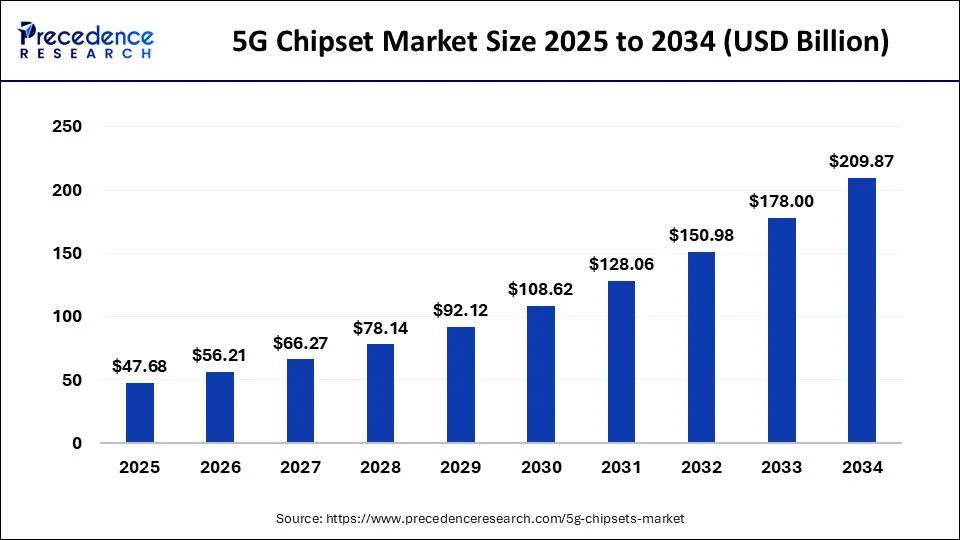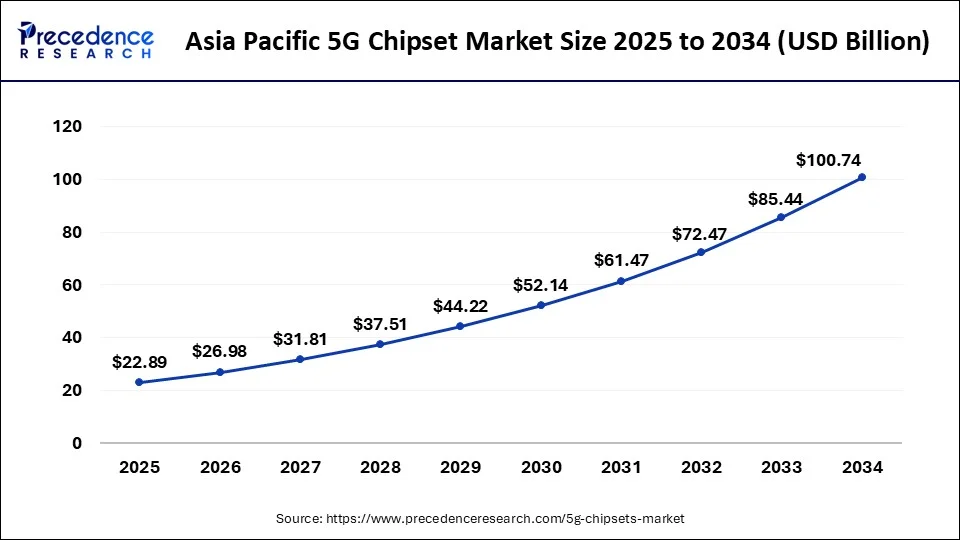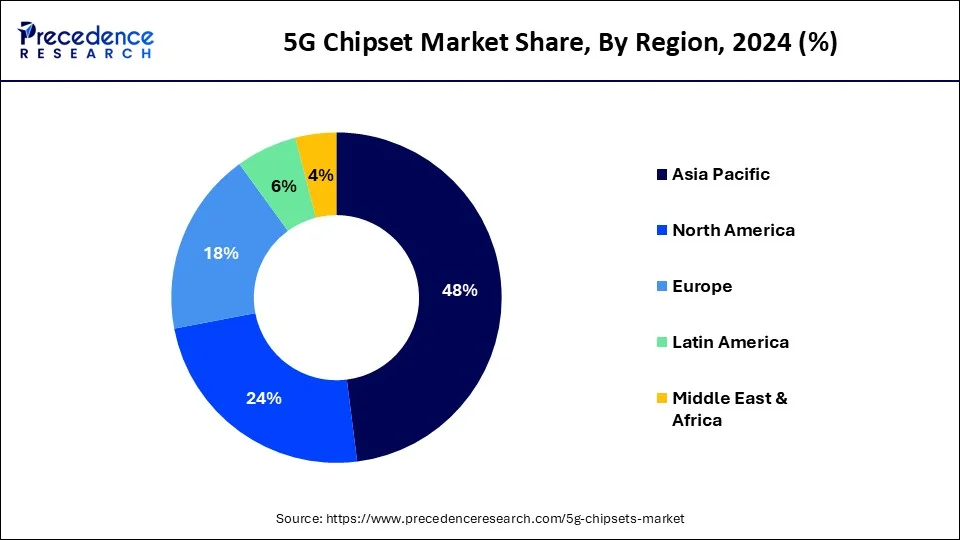List of Contents
5G Chipset Market Size and Forecast 2025 to 2034
The global 5G chipset market size was estimated at USD 47.68 billion in 2024 and is predicted to increase from USD 56.21 billion in 2025 to approximately USD 247.43 billion by 2034, expanding at a CAGR of 17.90% from 2025 to 2034. The 5G chipset market depends highly on the growth of the demand for Internet at higher speed, vast coverage, increase in IoT connection, and smart city projects.

5g Chipset Market Key Takeaways
- Asia Pacific dominated the global market with the largest market share of 48% in 2024.
- By frequencytype, the sub-6GHz sector segment contributed the biggest market share of 65% in 2024
- By processing node type, the 7 nm segment captured the highest market share of 64.8% in 2024.
- By deployment, the smartphones/tablets segment held the major market share of 55.4% in 2024.
How does AI impact on 5G Chipset Market?
AI-driven 5G chipsets will offer better control and utilization of resources to devices that are connected to such networks and influence the enhanced efficiency of the network. AI and 5G are critical to building intelligent infrastructure, for apps such as facial recognition, contactless ticketing, surveillance, and plane instrumentation. AI algorithms can use information to recommend that network resources should be better allocated.
Asia Pacific 5g Chipset Market Size and Growth 2025 to 2034
The Asia Pacific 5G chipset market size was valued at USD 22.89 billion in 2024 and is expected to be worth around USD 120 billion by 2034, rising at a CAGR of 18.02% from 2025 to 2034.

Asia Pacific held the majority of the market, with a share of around 48% in 2024. This is due to the quick increase in expenditures made in base stations that support 5G New Radio (NR) frequencies and handsets that support 5G technology. Important regional businesses, including Huawei Technologies Co. Ltd. and Samsung Electronics Co., Ltd. are spending heavily in the creation of 5G chipset modules.
- The GSMA's Mobile Economy report predicted that the introduction of commercial 5G networks in the markets next year will result in the Asia region having 675 million 5G connections by 2025.

A rising need for smart manufacturing in developing nations like China and India is anticipated to increase the use of 5G chipset components throughout the forecasted period. The market in the United States is expected to expand dramatically during the next years. Significant investment is being attracted to the creation of smart cities, smart industries, and home automation in the US. Online gaming with advanced visuals is becoming more and more popular with American players. The country is also becoming a pioneer in the usage of autonomous vehicles and smart transportation infrastructure. All of these developments are expected to boost demand for 5G chipset components in the US.
- GSMA forecasted that the total number of consumer and industrial Internet of Things (IoT) connections in North America will reach 5.4 billion by 2025.
Market Overview
The goal of a 5G chipset is to enable the end user to create a wireless network that adheres to 5G network requirements. It is an improved part of customer premises equipment and network equipment. The proliferation of devices with internet access has increased the need for 5G, a brand-new wireless infrastructure. After the current 4G LTE mobile network, 5th wireless (5G) is the following generation of smart mobilenetworks. These networks provide a perceived total global connectivity by extending broadband wireless operating frequency (Operational Frequency) beyond mobile broadband to the Internet of Things (IoT) andimportantcommunications segments. The lowest 5G chipset solution for the upcoming generation is also anticipated to bring new levels of efficiency and performance, allowing novel user experiences and the connecting of brand-new industries. In addition, the expansion of the 5G chipset business is fueled by the increased demand for 5G network infrastructure solutions, which makes it possible to link new sectors and maximize efficiency while minimizing cost.
Due to the widespread use of M2M and IoT connectivity, the 5G chipset market is anticipated to expand significantly over the course of the forecast period. The industry is expanding as a result of the rising demand for high-speed internet and extensive network coverage. Additionally, throughout the anticipated period, a rise in demand for mobile broadband operating frequency is anticipated to fuel the expansion of the 5G chipset market.
However, high investment costs, difficulties implementing the 5G network in terms of technology and infrastructure, and privacy and security concerns are some of the key reasons limiting industry development. On the other hand, increased government efforts in Asia-Pacific to develop smart cities are anticipated to create attractive chances for the market for 5G chipsets to expand over the projected period.
5g Chipset Market Growth Factors
- Rising Demand for High-Speed Internet: Rising consumer traffic resulting in a need to access the internet at faster rates, boosts chipset requirements.
- Extensive Network Coverage: The desire for high penetrations of 5G networks is driving the market.
- IoT Connectivity Growth: Growing Machine-to-Machine (M2M) and Internet of Things (IoT) markets require an increased number of chipsets.
- Government Initiatives for Smart Cities: New opportunities appear because large-scale investments in smart city projects are being made in the Asia-Pacific region.
Market Scope
| Report Coverage | Details |
| Market Size in 2024 | USD 47.68 Billion |
| Market Size in 2024 | USD 56.21 Billion |
| Market Size by 2034 | USD 247.43 Billion |
| Growth Rate from 2025 to 2034 | CAGR of 17.9% |
| Base Year | 2024 |
| Forecast Period | 2025 to 2034 |
| Segments Covered | Type, Frequency Type, Processing Node Type, Deployment Type, End Use, and Geography |
| Regions Covered | North America, Europe, Asia-Pacific, Latin America, and Middle East & Africa |
Market Dynamics
Drivers
- Rising Demand for High-Speed Internet - The market for 5G chipsets is anticipated to expand as a result of the rising demand for fast internet and extensive network coverage for a variety of applications, including remote learning, autonomous driving, live streaming, multiuser gaming, videoconferencing, telemedicine, and augmented reality. The development of 5G mobile network is being fueled by rising requirements for mobile internet services, high-speed data transport, and information and data processing. Additionally, it is anticipated to improve mobile network performance characteristics and close the data connectivity gap that still exists in the existing network generations (3G/4G).
- Growing mobile data traffic - Today's users may benefit from better data speeds and lower latency owing to cellular networks' continual development. The rapid rise in data volume is mostly attributable to consumer demand for video as well as industry and consumer initiatives to adopt cloud services. The need for mobile data services is primarily being driven by the rising use of services and applications in consumer electronics and business-to-business (B2B) communications networks, which are currently using/testing data-intensive apps like AR and VR, 3D, and ultra-HD video content.
Challenges
- High cost of 5G chipset for mobile devices - The cost of 5G-capable smartphone chipsets will probably be higher than that of existing 4G chipsets. First-generation 5G chipsets were only available in 2019 in high-end handsets. Second-generation chipset-based 5G devices are expected to be widely deployed in 2020, while third-generation chipsets will allow performance-optimized 5G devices in 2021. Only a small number of high-end smartphones employ Qualcomm's flagship Snapdragon 8-series SoC, which only supports 5G. By making its 7-series and 6-series lineups available on 5G, the business intends to dramatically increase its 5G selection. For mid-range smartphones, Snapdragon 765 or Snapdragon 690 are currently available. The 4-series chipset, which are utilized in less expensive phones, has not yet received any announcements from the firm. A significantly wider audience for the network technology would be provided by the inclusion of 5G in less expensive phones. It is anticipated that Qualcomm and MediaTek would reduce the cost of their 5G chipsets for mid-range handsets.
Opportunities
- Increasing Cellular IoT connections - The speed and dependability of 5G are expected to have a substantial influence on machine-to-machine (M2M) and the Internet of Things (IoT). The increased use of developing M2M technologies is primarily being driven by their enhanced communication capabilities and decreased power consumption. The existing capacity of mobile networks must be sufficient to handle the billions of nodes that are predicted to proliferate over the next few of years in order for M2M communication to be effective. M2M communication technology will be widely used in heavy manufacturing and process sectors to increase the efficiency of various processes and reduce human involvement with machines (such as the food industries). M2M connectivity is therefore expected to help the 5G chipset industry.
- Growing Mobile Data Traffic - Today's users may benefit from better data speeds and lower latency owing to cellular networks' continual development. The rapid rise in data volume has mostly been caused by consumer demand for video as well as industry and consumer initiatives to adopt cloud services. The demand for mobile data services is primarily being driven by the growing use of functionalities in consumer devices and business-to-business (B2B) communications networks, that are currently leveraging data-intensive applications such as Augmented reality technology, VR, and 3D, as well as ultra-HD video content.
Frequency Type Insights
The sub-6GHz sector led the industry in terms of value in 2024. This is a result of major market participants initially releasing 5G chipset components that enable the sub-6GHz spectrum for laptops, linked automobiles, and smartphones.
Due to the ongoing release of cutting-edge chipset components that support both the sub-6GHz and mmWave frequencies in a single module, the sub-6GHz + mmWave category is anticipated to see a discernible CAGR throughout the projection period.
Processing Node Type Insights
In 2024, the 7 nm category dominated the market in terms of value. This is a result of major players first concentrating on building 5G chipset components using a 7nm processor node. MediaTek Inc., Huawei Technologies Co. Ltd., Intel, and Qualcomm Incorporated, among other well-known industry participants, are concentrating first on building 5G chipset components using a 7nm processing node. Additionally, in order to enable high band frequencies, these market participants are presently concentrating on producing 7 nm and 10 nm processor nodes of the chipset.
However, given that they will need to support several applications at once, modern communication networks are anticipated to experience increased demands. The creation of a new chipset with faster processing rates would be required as a result. As a result, the 10 nm category is anticipated to post a sizable CAGR throughout the projection period. Additionally, if autonomous vehicles become more prevalent, a bigger number of processing nodes would need to be implemented in order to create 5G chipsets in order to ensure smooth connection between vehicles.
Deployment Insights
The smartphones/tablets sector led the market in 2024. This can be attributable to the rising demand for smartphones with 5G capabilities for applications such as video chatting, online gaming, and watching Ultra High Definition (UHD) videos. The demand for 5G chipsets has been rising across a range of devices and equipment, including broadband access gateway equipment, smartphones and tablets, connected cars, and linked gadgets. Additionally, the demand for components for next-generation chipsets has expanded as a result of ongoing expenditures in the deployment of next-generation telecom network infrastructure.
5g Chipset Market Companies
- Qualcomm, Inc. (US)
- Intel Corporation (US)
- Samsung Electronics Co., Ltd. (South Korea)
- Qorvo, Inc. (US)
- Huawei Investment & Holding Co., Ltd. (China)
- Xilinx, Inc. (US)
- Analog Devices, Inc. (US)
- NXP Semiconductors N.V. (Netherlands)
- Marvell Technology Group (Bermuda)
- Broadcom Inc. (US)
- Murata Manufacturing Co., Ltd. (Japan)
- Renesas Electronics Corporation (US)
- Infineon Technologies AG (Germany)
- Anokiwave (US)
- MACOM Technology Solutions Holdings Inc. (US)
Recent Developments
- In August 2024, Xiaomi released its own 5G chipset for smartphones in 2025, developed in partnership with Unisoc, which will supply the 5G modems for the SoC.
- In July 2024, Qualcomm released the Snapdragon 4s Gen 2, an affordable chipset designed in India. This chipset will allow manufacturers of mobile devices to offer 5G smartphones on a standalone (SA) network for sale.
- In February 2024, Apple expanded its partnership with Qualcomm for 5G modem chips until 2027. During a CNBC interview, Qualcomm CEO Cristiano Amon announced that Apple has agreed to prolong its patent license deal concerning the 5G modem until March 2027.
- In November 2023, Viettel High Tech created its own 5G chipset. The 5G DFE chip can execute 1 quadrillion calculations every second.
- In May 2022, MediaTek Inc. introduced its initial mmWave 5G chipset, the Dimensity 1050 System-on-Chip (SoC), designed to enhance the upcoming 5G devices in terms of connectivity, screens, gaming, and energy efficiency. MediaTek Inc. also announced two additional chipsets, the Dimensity 930 and the Helio G99, to expand their range of 5G and gaming processors.
Market Segmentation
By Type
- Modem
- RFIC
- RF transceiver
- RF front end
By Frequency Type
- Sub-6 GHz
- 26–39 GHz
- Above 39 GHz
By Processing Node Type
- 7 nm
- 10 nm
- Above 28 nm
By Deployment Type
- Telecom Base Station Equipment
- Smartphones/Tablets
- Connected Vehicles
- Connected Devices
- Broadband Access Gateway Devices
- Others
By End Use
- Manufacturing
- Energy & Utilities
- Media & Entertainment
- IT & Telecom
- Transportation & Logistics
- Healthcare
- Others
By Geography
- North America
- Europe
- Asia-Pacific
- Latin America
- Middle East & Africa (MEA)
For inquiries regarding discounts, bulk purchases, or customization requests, please contact us at sales@precedenceresearch.com
Frequently Asked Questions
Ask For Sample
No cookie-cutter, only authentic analysis – take the 1st step to become a Precedence Research client